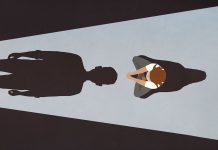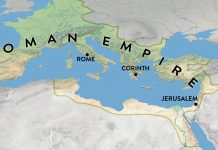On the days of the death and resurrection of Jesus Christ, there were at least ten other events that would have disrupted and animated any editorial meeting. Within a very short space of time, unique events with historical implications took place, in different dimensions and in different areas.
From a chronological point of view, during the last three days of Passion Week, the people of Jerusalem experienced revolutionary upheavals that might occur perhaps only once a century. They were signs of their times. At midday on Resurrection Sunday, the editors of a publication meeting to prepare the Monday edition would have had an extremely busy agenda; an entire history had been crammed into three days.
Signs in the religious world
The Patriarch of the nation—threatened with the death penalty
Friday morning in the Sanhedrin. Confronted with a young religious leader simultaneously considered a miracle-worker, a charlatan, or the Messiah, the High Priest of the people of Israel had the unique opportunity of his ministry: to renounce the office of High Priest in favour of Christ—the One foretold in the daily Temple services. But instead Caiaphas tore his clothes when he heard the testimony of Jesus Christ that He was the Messiah, the Son of the Most High God (Matthew 26:65). The prelate’s act of rebellion, of radical denial of such a claim, shocked the members of the Sanhedrin, for the high priest was forbidden by law to do so (Leviticus 21:10). The risk Caiaphas took was the death penalty for disregarding the sacred service of the priesthood. In a calculated move, Caiaphas cornered the Sanhedrin into a stark dilemma: either publicly reject Jesus as the promised Messiah or endorse His execution (Matthew 26:66). By presenting the issue in such absolute terms, he left no room for neutrality, forcing the religious leaders to act in direct opposition to the very hope their faith had long awaited. Caiaphas, the patriarch of the nation, prevailed. The humble teacher from Nazareth was handed over to the Romans.
News headline: NEVER-BEFORE-SEEN—High Priest Tears His Priestly Garment
Tearing of the Temple veil
Friday night in the Temple. As Jesus died on the cross, something unprecedented in the history of Israel happened in the Temple. As if ripped by an unseen hand, the huge veil that separated the central chambers of the Temple—the Holy Place and the Holy of Holies—was torn from top to bottom, without any human intervention (Matthew 27:51). This event, which could be seen either as a bad sign or as an indication of the end of temple worship, was not and could not be blamed on anyone. The secrets of the altar became visible to any layman, not just the high priest. Since he had already torn his priestly garments that morning, the second event was a confirmation of a providential intervention that suggested the abolition of the Jewish sacrificial system. If the curtain of any national cathedral were torn in two, the whole of society would probably speak only of the sins of the clergy and the people, perceiving in such a silent manifestation a most unfortunate foreshadowing.
News headline: NEVER-BEFORE-SEEN—Temple Veil Torn From Top to Bottom
Signs in the political world
Reconciliation between two opposing political leaders
Friday morning in the royal household. Politically motivated positions at the top of the administration have always been divisive, with political leaders from different factions often finding themselves in official positions that put them at odds with each other. To reach a consensus, especially at such a high level, and to sign the documents of an alliance is exceptional. Condemned by the Sanhedrin, Jesus was brought before the Roman procurator Pontius Pilate. Finding Him not guilty, the Roman handed Him over to the king under whose jurisdiction the Galilean defendant fell. Again, Jesus was found not guilty and sent back to Pilate. However, the Bible says that “that day Herod and Pilate became friends—before this they had been enemies” (Luke 23:12). We don’t know the reasons for this, but we do know that the only thing they did was to send Jesus to each other for judgement, thus renouncing their authority. Strange peace!
News headline: NEVER-BEFORE-SEEN—Former Enemies Pilate and Herod Sign An Alliance
Criminal with messianic ambitions
Friday morning at the judgment seat. Pilate faced Jesus. Confronted with the dilemma he had faced before—the condemnation of a man accused under Jewish law, but with no clear violation of Roman law—Pilate resorted to a ruse. Every year at Passover he would pardon a condemned man on death row. Resolving to let the people decide, he presented them with two condemned men: Jesus, who was guilty of considering Himself “King of the Jews”, and Barabbas, who “had committed murder in the uprising” (Mark 15:7). Jewish revolts were not social or political without also being religious. The leader of each revolt was a candidate for the role of Messiah, the deliverer of the people from the Roman yoke. The fact is that Barabbas, the nation’s chief brute, was set free at the request of the people, while Jesus was crucified.
News headline: Murderer Barabbas Pardoned
Signs in the social world
Full obedience
Friday morning, the town square. Faced with a choice, the representatives of the people and the citizens of Jerusalem, the capital, shouted in unison, declaring their allegiance to the Roman emperor. Although they wanted to free Barabbas, who was probably already planning his next revolutionary attack, the people declared loud and clear, “We have no king but Caesar” (John 19:15). There are rare moments like this in the life of a nation, when there is a collective denial of history, of expectations, of the fulfilment of a unique destiny as a chosen people. It was a never-before-seen moment that confirmed the complete victory of the Roman conqueror. The people renounced the Messiah, crying out that “anyone who claims to be a king opposes Caesar” (John 19:12).
News headline: NEVER-BEFORE-SEEN—Jews Swear Allegiance To Caesar
A curse that spans generations
Friday morning in the town square. The people’s choice was not made in ignorance. Pilate, although a corrupt politician, realised that he was taking part in a mock trial. As the main character, Pilate washed his hands in front of the people as a gesture of exoneration, declaring himself innocent of condemning Jesus. His last words are jarring: “It is your responsibility!” And the people in the town square replied, “His blood is on us and on our children!” (Matthew 27:24-25). It was not about the country’s debt to the IMF, nor about the interest on loans contracted by one regime and paid by another. It was about the life of a man whose death would determine the fate of a people for generations to come (John 18:14). The people found themselves in the situation of Caiaphas: either He dies or we die (we revolt). And they chose to let Him die: “Crucify Him!”
News headline: Self-Imposed ‘Blood Curse’ On the Jews
Locking the barn door after the horse has bolted
Saturday and Sunday morning. Satisfied with the success of Friday night, which had led to the crucifixion of Jesus, and yet cautious, the priests went to Pilate to ask him to keep watch over the tomb of the Nazarene. The request was not motivated by fear of His resurrection, but by the possibility that His body might be removed from the tomb, so that Jesus could later be said to have risen. The tomb was sealed, the stone was put in place, and the guards were instructed to keep watch at all times. Yet, early Sunday morning, the tomb was empty. The rumour that spread was that the Master’s disciples had stolen His body while the soldiers “slept”. But what soldiers would sleep on guard? And more importantly, what soldiers would admit to sleeping? It cannot be overlooked that it was a Roman guard who would have had to pay with his life for such an excuse. Nor can it be overlooked that we are talking about a dead man and a tomb, some frightened disciples and some helpless women. The rumour was, of course, the invention of the priests, who, together with the elders, “devised a plan” and “gave the soldiers a large sum of money” (Matthew 28:12).
News headline: Roman Guard “Loses” Body of Executed Convict
More than an eclipse
Friday noon, nationwide. Most eclipses last only a few minutes, with about seven minutes being the maximum possible duration. What’s more, they are only visible in limited areas at the same time and under the same conditions. At the moment of Jesus’s agony, “from noon until three in the afternoon darkness came over all the land” (Matthew 27:45). Undoubtedly, “the sun stopped shining” (Luke 23:45). A three-hour eclipse over the whole land is not just an unparalleled moment; it should have been clear that something more than a natural law and the proportionality of the solar system was at work. It was a supernatural intervention that would have deserved first place in the news log and first place in the commentary of the knowledgeable: scientists, theological specialists, and so on.
News headline: NEVER-BEFORE-SEEN—Three-Hour Eclipse
Earthquake
Friday, 3pm, Jerusalem. Earthquakes usually cause loss of life. On Good Friday there was an earthquake that split open the rocks and opened the tombs to reveal the bodies of the resurrected saints (Matthew 27:51-53). Earthquakes tend to dominate other news and make the headlines. An earthquake that raised the dead would make the news for many weeks. People were probably frightened, shaken, but strangely the Bible doesn’t talk about this event at length, just mentions it.
News headline: NEVER-BEFORE-SEEN—Earthquake Opens Graves
Second earthquake
Sunday morning, the city of Jerusalem. Every earthquake is known to have aftershocks. But just as the earthquake on Good Friday opened the tombs of the saints, so did the earthquake on Resurrection Sunday open the tomb of Jesus. The only difference between the two was that the second earthquake, the aftershock, was more powerful than the first, or in the words of the Bible, “a violent earthquake” (Matthew 28:2). Perhaps it was because there had been a death on the Friday and a resurrection on the Sunday.
News headline: NEVER-BEFORE-SEEN—Aftershock Larger Than First Earthquake
On the road to Emmaus
In addition to these ten events, which on any normal day would surely be front page news, the death of a poor teacher from a notorious locality would probably make the obituary section of a newspaper, where a small group of friends would spend a paragraph mourning his death. None of these events, however, have gone down in history on their own, but only in relation to the great event of the death and resurrection of Jesus Christ.
On Resurrection Sunday, two of the disciples of the Galilean were travelling from Jerusalem to Emmaus, “talking with each other about everything that had happened” (Luke 24:14). On the way, they were joined by a stranger who struck up a conversation with them and asked them what they were talking about. “They stood still, their faces downcast. One of them, named Cleopas, asked Him, ‘Are you the only one visiting Jerusalem who does not know the things that have happened there in these days?'” (Luke 24:13-19) They weren’t talking about the earthquake or the eclipse or the tearing of the veil in the temple and all the rest—not because they were out of touch with reality, but because these signs were mere incidents compared to the crucifixion.
Unfortunately, the two disciples were talking about a crucifixion that had shocked them, not one that had fulfilled their expectations. The Master’s death had completely shattered all their plans. This crucifixion was the defeat of the Word of God (as they knew it at the time). The event they were talking about was the event that had completely annihilated all the other events that had been projected in their imaginations. The crucifixion, and only the crucifixion—that is, death without resurrection—was the news.
On the way to Act III
The death of Jesus was only the first act of the drama. The resurrection that followed, the second act, made it the defining event in the history of this world. And the fate of Jesus is as important and relevant to society today as it was then. Freed from the hustle and bustle of news and headlines, the people of the third millennium also need to rediscover the life-changing event. Not just an emotional, cultural and social recognition, perhaps taken from a mass or an Easter sermon, nor the heavy sigh after watching the movie Jesus of Nazareth for the umpteenth time. Not just the diluted response, “He is risen indeed” to the pious and joyful greeting, “Christ is risen”. The reality we have to face is that we are like the father of the demon-possessed child, who, realising his own weakness, cried out to Jesus, ‘I do believe; help me overcome my unbelief!’ (Mark 9:24).
Like someone who did not believe in the resurrection they had already heard about (Luke 24:22-24), the two disciples on the road to Emmaus experienced the paradox of talking about the Risen One with Himself. This is nothing other than the state of secularised society: to talk about Him without believing in Him. And, unfortunately, it is also the irony of some baptised Christians: to speak to Him without believing in Him. From this perspective, some of us may still be the only strangers who haven’t found out what really happened there—and this while Act III has yet to be completed: “…and He will come again”.
From that perspective, some of us may still be the only strangers who haven’t found out what really happened there. And this, while Act III has yet to be completed: “…and again he will come.”



















